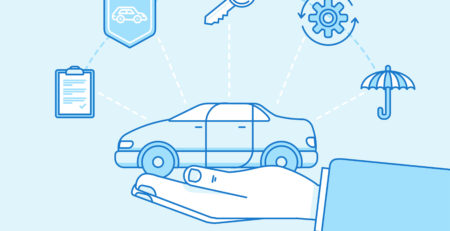For any business providing company vehicles, maximising safety for staff is a key consideration. Health and safety in the workplace extends to company vehicles, so the employer has a legal obligation to make sure employees are as safe as possible while out on the road. There are a number of steps fleet managers can take to ensure the safety of their drivers, such as offering them advanced driving courses, carrying out risk assessments or checking licence details. However, there is one more tactic businesses are increasingly turning to – a step that has been revolutionising fleet driver safety for the past decade: telematics.
Many businesses, from various industries and backgrounds, are installing telematics systems to their fleets. The word ‘telematics’ is a combination of telecommunications and informatics. Telematics is technology that can be added to any vehicle – usually in the form of a small black box – to send, receive and store information about the way the vehicle is being driven. Today, due to the popularity of telematics, many vehicles are being offered to fleets with ready-made telematics tracking systems built-in. These systems can record aspects about a person’s driving such as speed, braking, accelerating, swerving and taking corners. This information can then be relayed back to the fleet manager and can help to flag up potentially dangerous driving habits as well as those habits that could potentially be costing the company money.
Telematics as a training tool
Anyone running a fleet will know how important is it to ensure staff are driving their vehicles safely and responsibly. Once installed into company vehicles, a fleet telematics system can help to:
- Identify drivers who may benefit from further training – if drivers consistently display evidence of bad driving habits
- Help to establish the type of training a particular person needs – for example, if the fleet manager discovers that one particular employee is consistently breaking speed limits, they can choose to put that driver on a speed awareness course and can alert the driver to that behaviour before it causes an accident.
- Identify potential problems through valuable insights – enabling fleet managers to take a proactive approach to addressing these issues and preventing accidents
- Analyse poor driving behaviours – these systems enable fleet managers to go a step further than simply identifying a problem, as highlighting problematic patterns in driving can get to the root cause of the problem. For example, poor driving behaviours that consistently take place at the end of a shift could be as a result of fatigue; the company can, therefore, look to reduce that employee’s hours or refrain from giving them driving jobs at the end of a shift.
Many companies choose to put scoring systems into place to identify poor driving. For example, storage and management company Iron Mountain has put in place a telematics system that flags poor drivers as those that have recorded more than 20 bad driving habits in one ten hour driving period. At the end of each week, the company produces driving reports, which flag up those drivers with more than 20 bad habits recorded in one shift. A risk profile is then formed for each driver and training is provided to those where it is deemed necessary.
Telematics to influence driver behaviour
Of course, telematics’ main purpose is to be a used as a monitoring tool, so that fleet managers can be aware of each of their drivers’ habits. However, many people will consciously improve their habits if they know they are being monitored, so being open about your company’s telematics systems can have a positive impact. Many people will not purposely drive in an unsafe manner, but, by making a conscious effort to drive safer, they are often able to ditch bad habits. A recent study by the US Department of Transportation concluded that truck drivers improved their driving behaviour partially due to an awareness of being monitored.
Competitive safety
Another effective way to introduce telematics devices into workplaces is through competition. As fleet management systems can produce individual reports on each driver, they can be used to create the following for staff as a way of motivating them:
- Competitions
- League tables
- Reward systems.
Top drivers can be rewarded with incentives such as gifts, vouchers and extra cash.
Of course, there are those that finish bottom of league tables that may feel that their driving skills are not good enough to win any prizes. The negative side of introducing league tables that consistently reward top drivers is that other drivers will lose interest and therefore not even try to compete, not improving their driving. A way to encourage these drivers to make an effort to participate is to also offer prizes for the greatest improvement in driving behaviour and safety. Businesses can also reward drivers for more specific aspects of driving, such as reduced idle time, softer acceleration and gradual braking.
Various reports have been carried out to prove the effectiveness of using telematics to reward people for safe driving. A recent report by the Government’s Transport Research Laboratory found that drivers using telematics boxes showed a significant improvement in their driving skills when rewarded with a cheaper insurance premium. Although this research was carried out in the consumer space, the same concept of rewarding for safe driving can apply to the workplace.
Providing clarity in event of an accident
As well as helping to keep employees safe while driving, telematics can also contribute to the safety of the employer. If an employee driving a company vehicle is involved in an accident that could have been prevented, an employer may be liable for damages if the case goes to court. Telematics devices can collect and store vital information about an accident – such as the reaction of the driver, the movements of the vehicle and the type of impact – which can help to clarify exactly what happened and who was at fault. This clarity of information can protect both the employee and the employer and can help reach a fair outcome for all parties.
Mobile apps enable employee interaction
Telematics systems have been around for several years now, and are expected to become even more widespread over the next few years. Today, drivers are becoming increasingly involved with their companies’ telematics devices thanks to many of the systems being rolled out via mobile apps. Whereas previously, information on employees’ driving habits was relayed back to only the fleet manager in the first instance, today mobile apps add a real-time element to storing and analysing driver information. Drivers are able to see real-time information recorded on their driving, thus helping them to understand where their strengths and weaknesses lie. By enabling employees to see information on their driving in real time, whenever and wherever they choose, businesses are encouraging them to take an active interest in the way they drive – ultimately maximising safety whilst driving.
Drivers using telematics systems with mobile technology capabilities can receive instant text messages when they are speeding when they have been idle for too long, if they’ve accelerated too hard, or any other bad driving habit that is detected.
Overall, telematics systems enable businesses to catch patterns of driving behaviour before they become a serious problem and then enable employers to take steps to reduce and eliminate that behaviour. Today’s systems are highly advanced, effective and are an asset to any business with a fleet.












